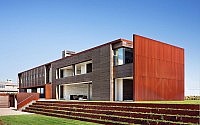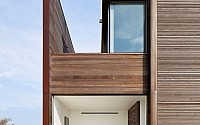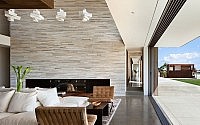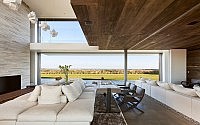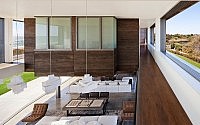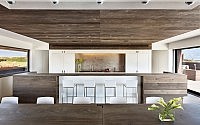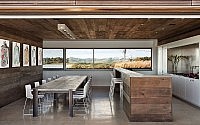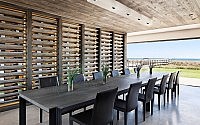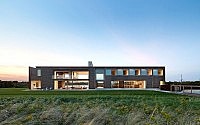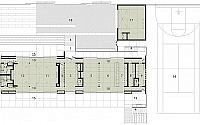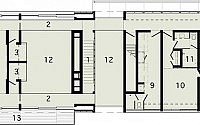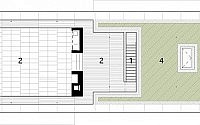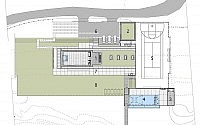Sagaponack by Bates Masi Architects
Bates Masi Architects designed this spacious minimalistic coastal residence located in Sagaponack, New York, for a large family and their numerous guests.
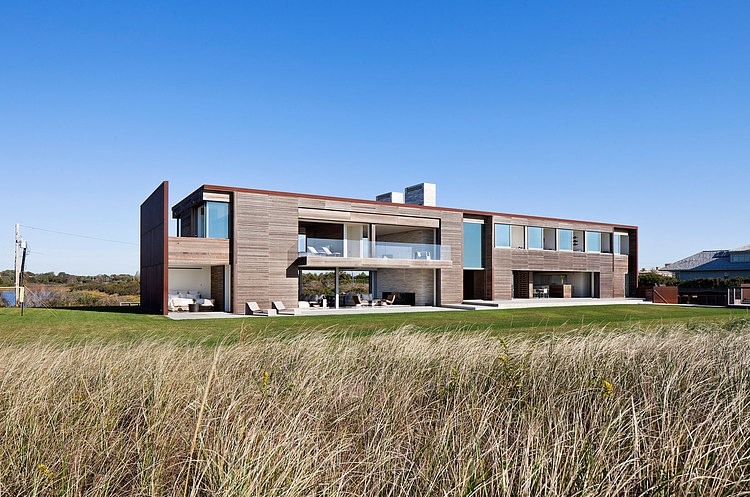











Description by Bates Masi Architects
Located between the Atlantic Ocean and a freshwater pond, this residence is for an adventurous couple and their four sons. They wanted a house for their large family and numerous guests with a lawn, swimming pool, pool house, garage, and sports courts on a site with a limited building envelope due to coastal and wetland zoning.
The large program, relatively small footprint, and daunting regulations dictated a building envelope densely packed with program that stood as a barrier between the ocean and the pond. Thus the design process was one of subtraction rather than addition: carving away at the solid mass of the house to reconnect site features and views and to distill the experience of the place.
Spaces run the full width of the house with floor to ceiling sliding doors on both sides. The spaces create apertures through which views, light, and air completely penetrate the house, dissolving its mass.
Passersby see directly through the house to the sky and landscape beyond. With the sliding doors open and recessed into the adjacent walls, interior spaces are transformed from formal rooms to open pavilions, merging seamlessly with the site.
The plinth of the elevated house is carved into a series of stepped planters that are further sculpted into the entry steps, mediating the different grades required by flood control regulations.
Besides dictating the minimum first floor height, regulations also set the roof height. To maximize the ceiling heights within those limits, the house utilizes a steel moment frame to pare down the thicknesses of the floors and roof to the absolute minimum.
The design strategy to accommodate the extensive program is to nest spaces within one another. Operable partitions pull out from the walls of the living room, carving out a media room within the living room when privacy is desired.
Conversely, with the partitions open, the media room merges with the living room for large gatherings. The thickness of the wall separating the dining room and kitchen is also cut away, utilizing its depth to accommodate a wine rack that also functions as a light fixture.
The process of carving is applied at the material and detail level as well. The 5/8” corten steel plate that clads the base of the house is waterjet cut into a delicate pattern that defies its mass. Inside, corian is employed for the ease with which it can be milled.
Corian countertops are cut to form towel bars, bunk bed frames are carved to create ladders, cabinet doors are recessed to form handles, and wainscoting is subtly etched with meaningful words chosen by the clients.
Materials were chosen not only for their workability, but also for their durability in the harsh coastal environment. Heavy gauge corten steel siding is zero maintenance in spite of being relentlessly sandblasted by the wind.
Cedar siding and screens are finished using a Victorian technique in which the iron sulfate in a blend of white vinegar and iron filings reacts with the tannins in wood, creating an ebony finish that penetrates through the material and will not require refinishing.
The lack of harsh stains or finishes reduces the ecological footprint of the house. Geothermal heating and cooling as well as vegetated roofs further reduce the environmental impact.
Using the design approach of sculpting away rather than building up, the house is pared down until the experience of the extraordinary site is dominant.





